The War in Ukraine Update (July 23, 2024)
I have previously prefaced the War in Ukraine Update with phrases such as “this won’t be easy reading.” In fact, I probably did that first a year ago when it was clear that Ukraine had been pushed into a counter offensive 1) without promised weapons and tanks 2) without even a promise of air cover and 3) months after letting the entire world know a counter offensive was coming—which resulted in miles-deep mine fields and the true cranking up of the Russian war machine.
In hindsight, there were voices of reason here—but they were possibly not quite what many would assume. For all of the criticism Ukrainian President Volodymyr Zelensky has taken at home, his performance has been remarkable. That he has 1) not given up or 2) even fled but still managed to lobby, reprimand and, yes, at times beg for weapons and support while being as successful as he has been is no less than mind boggling. Keep in mind that the majority of Ukraine still is AGAINST giving up the occupied territories. Likewise, keep in mind that he was under enormous pressure to show something for continued support--and with the weight of the US (which includes a military lobby that should be discussed at a later date), plus training, plus promises of F-16s, giving a green light to the counter offensive under said pressure and a US statements that it would certainly bring success is a much more understandable decision that it in hindsight it now appears.
So you could say that Zelensky was logical here—even if pushed and even if that decision was influenced by more than a quiet desperation that it would come true.
Then there was a second line of logic, this being that of now replaced four-star general and chief of staff, Valerii Zaluzhnyi, who had plans to take Crimea far earlier in a move that likely could have shortened the war—and here, not that Zelensky agreed.
To quote Business Insider: “During discussions with Western partners of plans for a 2022 counteroffensive, Ukrainian President Volodymyr Zelenskyy and Zaluzhny, his top general, both advocated for a push down to the Sea of Azov through the Zaporizhzhia region. At that point, Russia had not constructed the extensive minefields and fortifications that would hinder the 2023 counteroffensive there, lightening the breaching demands.
“Such an approach would have still been a daunting challenge and a gamble. The penetration would need to not only be deep but also sufficiently wide to prevent the Russians from counterattacking and threatening the flanks of the advancing force.”
Interesting is that Zaluzhny only wanted about 70 howitzers at the time. And that the US would not back the plan, as it was not yet convinced by Ukrainian “battle prowess.”
Yet it is very hard to argue that this was not the right move. In fact, there is a British SAS slogan that rings: “Who dares, wins.”
It was daring, and it was smart, and Russia was vulnerable. Instead—and here there is no denying this—the US pushed for Ukraine to wait, just as it pushed for a counteroffensive once the mine fields were already built. Even though no F-16s (or tanks at that time) were truly on the way.
And the US should not stand alone in such criticism. In the spring of 2023 the German Leopards were not on the way either.
And now here we, and despite the tremendous heat, the drying of battlefields that has enabled Russian meat waves (but not only, as I will note below), these are dark days for Ukraine. The Western press has stated that US shells and equipment have stopped the Russian offensive, but that statement could only be backed up at this time in Kharkiv. Key locations are crumbling, and a more logical argument would be that we are now seeing a disturbing turning point in the war. So much so that Zelensky is indeed “hinting” that negotiations are the only way out--as noted here: https://edition.cnn.com/2024/07/20/europe/ukraine-zelensky-uncertainty-russia-negotiations-intl/index.html .
And Russia has indicated that talks are (possibly) welcome. Which can be seen here: https://news.yahoo.com/news/kremlin-welcomes-zelensky-stance-talks-140751400.html
Such negotiations will already be viewed as Ukraine having lost the war. Much will remain to be seen should talks actually take place and result in even a temporary peace. Meanwhile, effectively forced negotiations will be in part blamed on US former president and current candidate Donald Trump, as well as on right-wing Republicans who have somehow forgotten US President (and Cold War legend) Ronald Reagan and the Russian threat. And yes, there is plenty to be passed around. Yet the Joe Biden administration’s tepid response to the 2022 invasion, the cowardly hold back on weapons and frankly bizarre push (he is, after all, the US commander-in-chief) for a counteroffensive that could no longer be a surprise in a heavily fortified location with only minimal military support is on… Joe Biden.
And on his watch the rebound of the Russian military, the stability of Europe and, considering the activities of China and India, the previous world order… has forever changed.
Likely, neither Republican nor Democrat will appreciate what I just wrote. But journey to Ukraine, speak with Ukrainian families and children and soldiers without arms and legs. Speak to women raped or teenagers with burns over 80 percent of their bodies. Have a look around at the cities, at the once potent breadbasket of Europe that probably can never be demined—certainly not in our lifetime.
And then tell me how much you like that.
And now, the update.
First, the general map in order that you may be (or get) familiar with the fronts. We'll run through the most important fronts from Kherson in the south all the way to Kharkiv in the north.
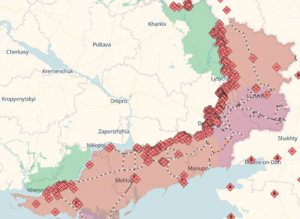
Kherson, Krynky
At this point in time it would appear that the last holdouts at Krynky have either been overrun or captured. Russian bloggers are in their sickening glee gloating and calling Krynky a game changer for morale in Ukraine, and admittedly there may be something to that, as the brave men that in the winter crossed into a swampy, icy hell of shelling and frostbite became those unable to dig in properly in an environment unsuited to sane defense. Details from the Ukrainian military are not forthcoming, and whether or not hundreds were lost or miraculously evacuated is unknown, but even Ukrainian’s Deep State UA maps appear to indicate that Russia is pushing into the no-man’s land of the river bank, and the foothold that was long seen to the southwest appears to be gone.
That said, Russian gloating is Russian gloating, and Ukrainian fighters are still rumored to be hunkered down between Pishchanivka and Oleshky, and here it should be said that they are still forcing Russia to divert resources to this front at a time when the Russian military has again temporarily depleted itself due to the meat waves of the past months (if not the past year).
Below is the previous foothold at Krynky as of July 10, followed by the current map:
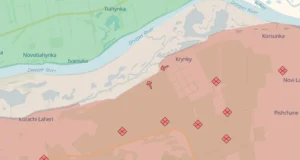
Krynky as of July 23
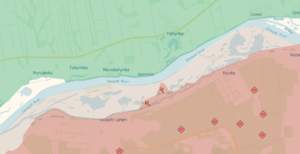
Zaporizhzhia front/Robotyne
Comparing the previous map to the current Deepstate UA map at first reveals only minor changes, but the concerted push up from Novoprokopivka, as well as from the southeast is rumored to be intense, with extremely bitter fighting. This has been called “positional” by some analysts, which may sound reassuring. At this time positional fighting is extremely difficult for Ukrainians due to glide bombs, drones and on some fronts thermobaric attacks.
An example for English reading folk can be seen at this link, which documents 450 such attacks on the Zaporizhzhia front in one day: https://www.ukrinform.net/rubric-ato/3887584-zaporizhzhia-region-remains-under-russian-fire.html
For those to lazy to read the link, here is a quote: “Robotyne and Novoandriivka were subjected to four rocket volleys. Also, 263 artillery shells were fired on Huliaipole, Novoandriivka, Robotyne, Mala Tokmachka, Malynivka, and Levadne.”
Robotyne as of July 22
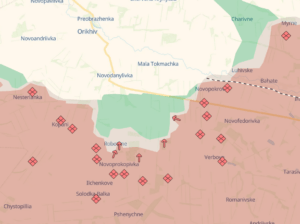
Staromayorske
This front has seen an ugly reversal with the Urozhaine gains of last year now lost. The drive for Makarivka and Blahodatne is on, and, although at first glance this may seem somewhat inconsequential, Russian intentions, taking into account the key Pokrovsk logistics point (which will be further highlighted) are largely clear, as continued drives from all points noted in red have the potential to carve out a large chunk of territory defended by stretched Ukrainian forces (the blue circle is only to make a point and is not indicative of Ukrainian positions or that they are currently cut off on scale).
Expect future headlines (even in the West) to focus on Pokrovsk, but if Russian forces make headway and get to Blahodatne soon… this spells trouble.
Staromayorske as of July 22
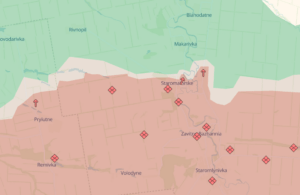
Urozhaine as of July 22
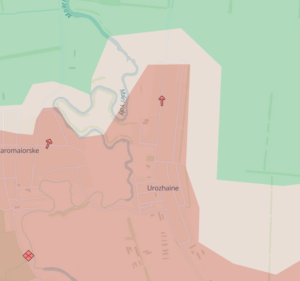
Vulhedar to Krasnohorivka
Below is the map that indicates fighting from Vulhedar to Krasnorhorivka. While there is little to report with regard to Vulhedar and Marinka, the southern half of Krasnohorivka appears to be mostly in Russian hands, although the second, northern half of that city, remains in Ukrainian hands and that battle will be the next phase. This town has seen recently very intense, street-by-street fighting, and although Russian bloggers have focused on small gains (literally one street at a time), anecdotal reports indicate that Russia is paying a high price.
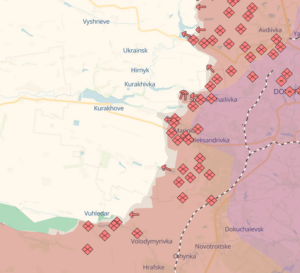
Krasnohorivka
No, it's not quite all gone, but mostly gone. Looks like a small part is still holding out, but the Ukrainians are almost certainly on the way out. The northern half/suburbs which lie along the Lovoza river is still in Ukranian hands (highlighted in blue). That said, by the evening of July 22 there were already reports of Russian gains in the northeastern suburbs.
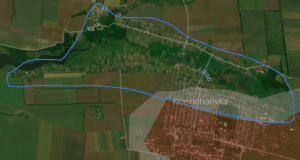
Avdiivka front (and intro into the beyond)
At least as troubling are the targeted Russian offensives beginning south of Avdiivka, where Russia is proving adept at creating small pockets that will be indefensible or dangerous to defend for Ukrainian forces—and which are more likely to pre-empt a series of quick pullouts in order to avoid encirclement.

The first such pocket of note is between Vodiana and Yasnobrodivka. Russian forces, including elements of the 9th Separate Motorized Brigade and the 80th Guards Red Banner Tank Regiment are driving into Karlivka but also on the north side of the Vodiana reservoir and from Yasnobrodivka along the souther side of the Vocha body of water. The combination of water barriers have already created a dangerous potential cauldron here, and it is expected that a pullout is already under way.
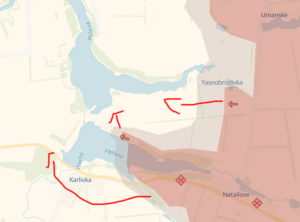
Yet North of the Vovcha is a second potential pocket created by the Vovcha and Russian attacks/advances at Novaselivka Persha, which is now believe to be entirely or almost entirely in Russian hands. This creates the unenviable situation where Ukrainian forces assumed to be in both pockets are unable to relieve each other, and relief forces to either pocket will be a hard go (although especially at Vodiana).
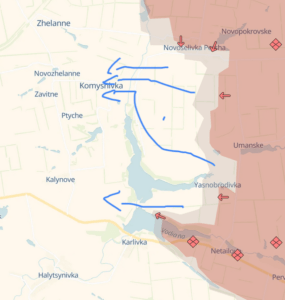
If Ukrainian forces do fall back to Kalynove at the Vodiana pocket, then Russian forces will have a hard go making fast progress. However, further north, Komyshivka would be expected to come under immediate pressure, although also expected is that the Ukrainians will dig in hard there.
Yet further north there are similarly dangerous pockets of potential encirclement created by the surprising advance by Russia at Prohres. This creates a potential pocket south and north of Prohres, and news that in the north that Lozuvatske has fallen is disconcerting. In order to understand scale, the gap between Russian forces at Lozuvatske and Russian forces at Prohres is only a few kilometers, and escape will also cost lives.
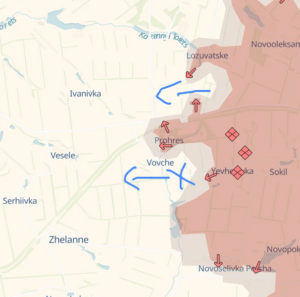
Those advances again point to the Russian focus on Pokrovsk, mentioned in the previous updates.
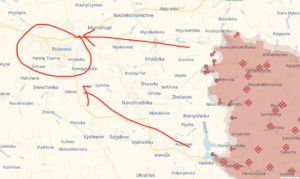
Just to retain perspective, here are three maps, all noting Pokrovsk, as well as the assumed Kramatorsk, Slovianks and eventual Borova objectives.
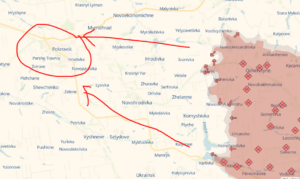
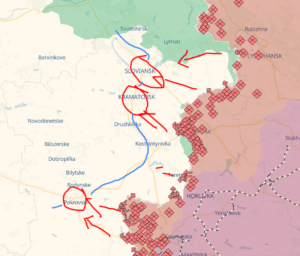
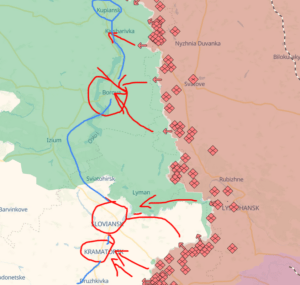
Back to micro fronts, again the Prohres-Lozuvatske pocket is high risk for Ukrainian forces, and advances at both points are seen to be increasing daily in the 500-meter to 1,000-meter range. Although these also seem to be micro advances, once again a glance at the narrow escape route afforded by that pocket indicate that this is not the case.
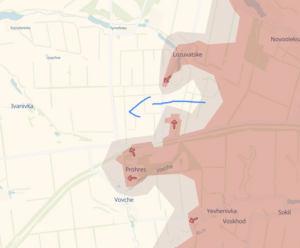
Also note that, as the crow flies, the distance from Prohres to Pokrovsk is not as great as it may appear when pouring our such map. In fact, Russian forces likely need to cover only 30 kilometers, which means they could conceivably at the current rate be beating on the door of that key hub within a month.
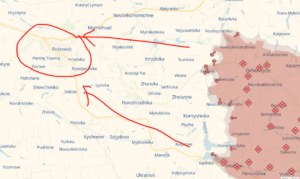
Further north east is the Niu York pocket (seen below... in the northeast below Toretsk). Here Russian forces made surprise gains over the past 10 days, and as can be seen with the Zalizne gains, this creates yet another worrying pocket.
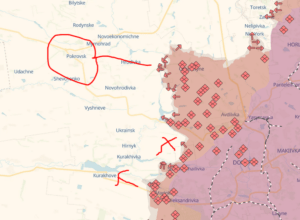
First, in the north of the pocket, Russia appears to have high ground and industrial mining areas, which pose serious problems for the Ukrainian forces in that pocket. At present, pro-Russian bloggers are claiming that up to two battalions of Ukrainians are trapped in said pocket with no relief in sight. Keep in mind, that Russian bloggers often put out such claims even weeks prior to a success (or defeat), but the hope is that Ukrainian forces (and this correspondent indeed does not know the numbers there) have already fought their way out or are currently in process. And again, the gap between Russian forces in the north and south is only a few kilometers.
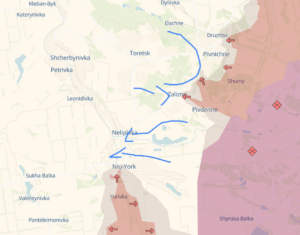
Please note that Russian bloggers are claiming that exhausted Ukrainians now prefer to surrender in that pocket instead of continue fighting in the war. This is highly doubtful, considering the real stories of Ukrainians that have returned in prisoner trades. So yes, the Russians are making gains, but do not buy into the propaganda.
Yet also note that Russian forces attacking along Zalizne are pushing toward Toretsk.
Also note that key to these advances appear to be the use of glide bombs and thermobarics, but also key is the improved use of close fire support through artillery, a skill that seemed to have eluded Russia in the first 18 months of the war.
Bakhmut/Chasiv Yar
While not at risk of becoming another pocket or encirclement risk, the Ukrainians appear to be in process of losing Andriivka south of Klischiivka, where the Russians had already made gains. Considering slow, but consistent gains at Chasiv Yar. This appears to possibly precipitate a drive for Kostiatynivka, which would be a natural target along the Pokrovsk-Kramatorsk-Sloviansk logistics line.
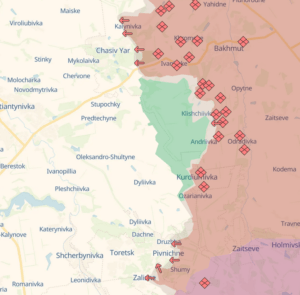
Much further north, with regard to the Svatove and Kupiansk fronts, the Borova logistics point on the Eastern side of the Oskil water way appears to be a long-term target, as not only are Russian forces pressing at Makiivka, but similar to Niu York, Russian forces advanced in terms of kilometers at Pishchane. This is far north of Borova, but a drive for the Oskiil at Senkove could be the plan, as this could potentially also cripple Ukrainian supply lines, just as would a real advance toward Borova.
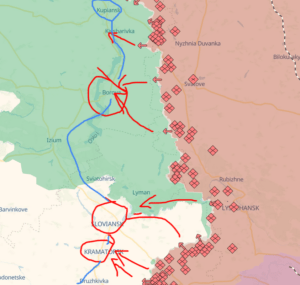
Below: Borova is some 30-35 kilometers from Russian advances at Andriivka, but the Makiivka forces may also target the same hub.
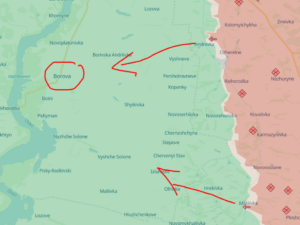
Currently, there are conflicting accounts with regard to Makiivka, with some Russian bloggers claiming it has fallen. This has not been confirmed by Ukrainian mapping, although Russian advances in the south are very evident.
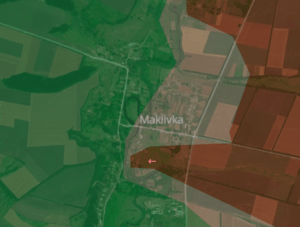
Further north at Pishchane, Russians have made sharp gains. This advance can be seen just below Kupiansk (vis-a-vis Nyzhnia Duvanka) on the map below:

Russian Pishchane gains seen below:
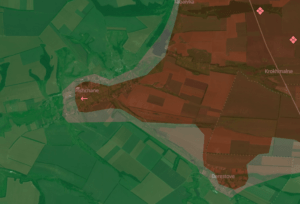
This effectively creates a new threat to Kupiansk, where Ukrainian forces previously were able to stop drives toward Synkiivka and Kupiansk itself. Below Kupiansk Ukrainian supply lines on the East side of the Oskil are seen, and they are vulnerable to what is now a multi-pronged Russian front.
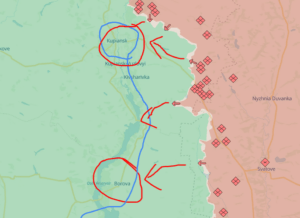
On the Karkhiv front, Russian forces have made gains at Vovchansk, and again Ukainian fighters have suffer hits from glide bombs, artillery and thermobarics, although at this moment, at least according to Ukrainian mapping, Russia has faced intense fighting and found it difficult to cross the narrow Vovcha river. As opposed to the previous hotspots, the Kharkhiv front sector appears stable, and Russian advances have slowed or sputtered out, likely in part due to American-supplied HIMARS and other artillery--as well as due to high Russian casualties over the past 60 days and, according to one source, "a lessened Russian will to fight."
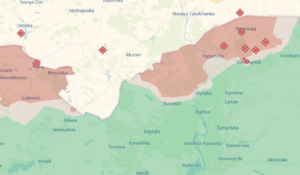
And thus we come to the end of today's update.
God bless the Ukrainian nation. Slava Ukrainii, and prayers that the tide will once again turn.
Preston Smith is a licensed investigator based in Gdansk, Poland. He can be reached at query@cddi.pl
All maps courtesy of Deepstate UA.
Photo credit: Residential building in Kherson, hit by Russian shell on 16 July 2024. Two apartments caught fire. Dsns.gov.ua, CC BY 4.0 <https://creativecommons.org/licenses/by/4.0>, via Wikimedia Commons.


